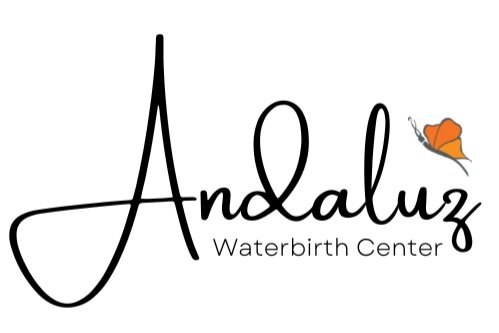
All About Waterbirth
Andaluz midwives lead Oregon professionals with our experience and skill in waterbirth. The benefits of laboring and birthing in water are numerous to both you and your baby and there is no better place in the Pacific Northwest to have a waterbirth than Andaluz! Our statistics speak to the safe and skilled care we give with over 4,000 babies born into our care and a 5% cesarean birth rate for women who begin labor care in the birth center.
What is waterbirth?
Many birth settings may offer the option of laboring in a bathtub for pain relief (also called “hydrotherapy”), but the term waterbirth refers to laboring in a tub during contractions, and staying in the tub during the pushing phase of labor until the baby is born. The baby is initially born under water, and then brought gently to the surface of the water shortly after.
Benefits of waterbirth
People who give birth in the water regularly report feeling greater overall satisfaction with their birth experience, as well as experiencing less anxiety and fear, and a greater feeling of control during the birth. Studies have also shown waterbirth to shorten the first stage of labor (the time you spend dilating from 1-10cm) by an average of 30 mins, and the entire duration of labor by an average of 50 minutes.
In their position paper on waterbirth, the International Childbirth Education Association lists these benefits:
Increased satisfaction with the birth
Reduction in the perception of pain
Increased endorphin release
Increased relaxation
Reduction in the need for medications for pain relief
More ease for assuming various labor/birth positions
Shorter first and second stage of labor due to a reduction in stress hormones and catecholamines, which can inhibit labor progress
Less perineal trauma
Less postpartum hemorrhage
Promotion of maternal/infant bonding behaviors
How does waterbirth work?
You can use hydrotherapy any time during labor for pain relief and relaxation, but many find it most effective during the active part of labor, when contractions are more intense.
For optimal pain relief, you should be immersed in water to cover your belly up to your breasts, which is easy to do in our large, deep birthing tubs. This kind of full immersion helps to stimulate oxytocin, which facilitates labor progress, and encourages the release of endorphins, the body’s own natural pain-relieving hormones.
Natural pain relief is also caused by the sensation of warm water on your skin, which stimulates large sensory neurons in your nervous system. When these afferent neurons are engaged they can function to block pain impulses which travel along smaller nerve fibers, utilizing the Gate Control method of pain relief.
Thanks to water’s buoyancy, which reduces the gravity-bearing work that your muscles have to do, laboring in water can be more restful than laboring on land. This encourages greater relaxation, which can also help release endorphins and ease muscle tension, resulting in less perceived pain.
The buoyancy of water also makes it easier to change positions which can lead to an increase in functional diameter of the pelvis, making more room for your baby to get into the optimal position for birth. It is also easier to support yourself in upright positions, so people who give birth in the water are more likely to use upright pushing positions.
Is waterbirth safe for me?
As long as your pregnancy is considered low-risk, waterbirth is a safe option for you.
During your prenatal check-ups, your midwife will continually evaluate your health and the progress of your pregnancy to ensure that you stay low-risk. During your labor your midwife and birth assistants will also frequently check on your health and emotional wellbeing, your baby’s health, and the progress of your labor to make sure that you continue to be a great candidate for waterbirth.
Studies have shown that giving birth in water has no adverse effects for birthing people, and can potentially have benefits, including lesser likelihood of severe perineal tears. The amount of blood loss experienced during waterbirth is equal to births that happen on land. There is also no increased risk of infection. Our tubs are thoroughly cleaned after each use and do not have jets or recirculation pumps to facilitate cleaning.
Is waterbirth safe for my baby?
Several studies have demonstrated that waterbirth does not carry any additional risks for newborns, including the need to transfer to the hospital, NICU admission, and breathing difficulties. In fact, babies may even experience better health outcomes!
Babies born in the water have similar APGAR scores (a quick test to evaluate the baby’s transition to life outside of the womb) at 1 and 5 minutes to babies born on land. There is also no increased risk of the baby experiencing low body temperature, since the water in the tub is usually very warm and the baby is given skin to skin contact immediately.
Babies born via waterbirth may be at less risk for developing infections, including Group B Strep (GBS), since the water may “wash away” or dilute harmful bacteria.
Some parents may be worried about their baby attempting to breathe immediately after birth while they are still submerged in the water, but there are several protective biological mechanisms in place that prevent that from happening. First, it’s important to remember that immediately after birth, babies still receive oxygenated blood through the umbilical cord as long as it is left intact.
During birth, babies are transitioning from a water-filled environment (the womb with amniotic fluid) to an air-filled environment, so when they are born into water they are still receiving similar stimuli to their womb environment. In order to know it is time to take that miraculous first breath, babies need to feel the sensation of air and gravity on their faces.
As they are lifted out of the water, the stimulation of air triggers the trigeminal nerve, located around their nose and mouth. This nerve is involved with the control of respiration, and stimulation to the nerve is one of the primary mechanisms that initiates the change in the baby's circulatory system and encourages the lungs to expand. For a more in depth discussion of the initiation of breathing in the newborn, you can read this article from The Journal of Perinatal Education.
Waterbirth is a safe and effective way for low risk people to welcome their babies into the world, and with our Andaluz midwives you are always in great hands. Check out the video below to see an Andaluz Waterbirth in action!
Resources for further reading:
